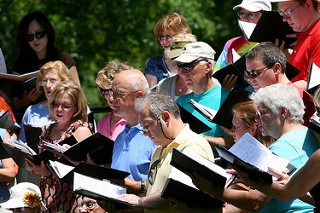 In my last three posts (Doin’ It, Doin’ It: Vocabulary, and Doin’ It: Museums) I have been exploring participatory experiences as being an important element in the work of arts organizations. This week I want to talk about participatory experiences in the performing arts.
In my last three posts (Doin’ It, Doin’ It: Vocabulary, and Doin’ It: Museums) I have been exploring participatory experiences as being an important element in the work of arts organizations. This week I want to talk about participatory experiences in the performing arts.
Options like pre-performance discussions and post-performance talkbacks have long served as interactive opportunities for event attendees. These are increasingly supplemented by social media information (e.g., background on works performed or live streaming of rehearsals), opportunities for Q&A with artists or staff members (often via Twitter), sharing of ideas and reactions with peers, and posting of “were you there?” pictures after the performance (taking into account, of course, restrictions on photographing the event).
There is also considerable potential for active participation in the performing arts. Some are relatively new ideas. Trained artists who are no longer practicing their art are having opportunities to perform created through programs like the Baltimore Symphony’s Rusty Musicians and Vermont’s Farm to Ballet Project. Other programs provide participatory opportunities for people who have not viewed themselves as performers. Older adults have been drawn into dance through projects like Liz Lerman’s Dancers of the Third Age. People who think they can’t sing are invited into opera in Milan’s Coro degli Stonati (loosely Choir of the Tone Deaf). To be honest that name is both misleading and, by and large, wrong. The work of the group is to get people past their psychological stumbling blocks to singing. Truly tone deaf people are exceedingly rare. Forklift Dance Works invites workers of all kinds–sanitation workers, gondoliers, arborists, Japanese softball players, and electric company employees–to be a part of the creation and performance of dance.
But some of the most promising options may be among the oldest. Community choirs (including symphony choruses), community theater, and community bands and orchestras in many cities predate creation of professional arts institutions. The range of performance these groups represent, from reading opportunities to professional in all but money, is vast. There is, unfortunately, a lamentable and nearly suicidal disdain on the part of some in the arts establishment for the work of such groups. If the need to support participation in the arts is critical to the health of professional arts organizations, condescension toward these ensembles is irresponsible. The world of the arts is an ecosystem in which each part should be as supportive of all others as possible. To do otherwise is foolhardy.
Arts participation is a patently obvious foundation upon which to build broad support for the arts. There are many ways to encourage participation. We need not all undertake all, but most of us should seriously consider moving forward on one or more.
Engage!
Doug
Photo:![]()
![]()
![]() Some rights reserved by JKleeman
Some rights reserved by JKleeman
